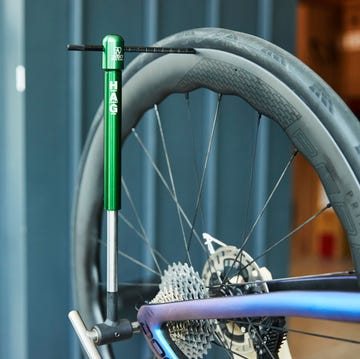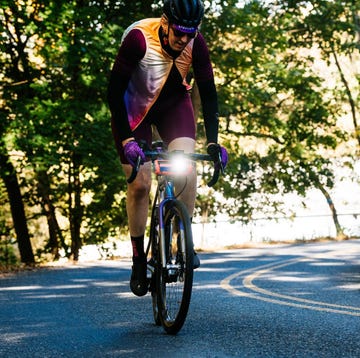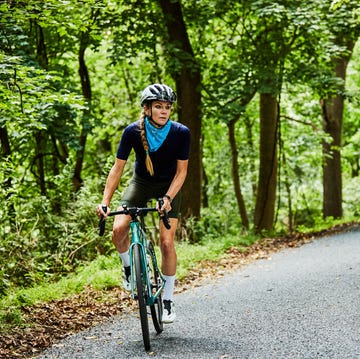Planning a long ride this weekend? Don’t be the cyclist who tries to leave the house only to realize your wireless shifter batteries are dead, you’re mildly dehydrated, your legs feel flat from yesterday’s hard intervals, and the clothing you picked absolutely doesn’t suit the weather forecast.
If you want to feel relaxed as you sip coffee ahead of spending hours in the saddle, here is exactly how to get ready for a long ride. We’ve outlined what your bike needs and how to prepare physically for your next big outing.
72 Hours Before a Long Ride
1. Head Out for a Spin as a Gear Check
Before any other preparations, do a quick bike check for any major issues, Ben Delaney, a gravel cycling expert, tells Bicycling. Three days out is a good time to make sure that you won’t have to find a bike shop en route. You also may want to make sure your tires are holding air, especially if your bike typically lives on the trainer with one wheel off.
If you typically ride indoors but you’re about to head out for a big outdoor ride, take a few minutest to go out for a quick spin, Delaney says, just to make sure your shifters and brakes are in working order and nothing is squeaking or squealing.
Now is also a good time to glance at the weather to troubleshoot and take care of both you and your bike. That could mean your bike needs fenders or you need to dig out winter gloves or shoe covers.
2. Do a Recovery Ride
“The last thing you want to do is just stop and do nothing in the days before a long ride,” Si Bradeley, coach and event manager at MyWhoosh tells Bicycling. “Your body is not going to respond well if you do nothing, then get up and head out on a hard ride. Seventy-two hours before my big ride, I’m definitely doing a recovery ride. That’s going to stimulate blood flow to your muscles, which is going to help you be as recovered and ready to ride as possible.”
Bradeley recommends riding for 45 to 90 minutes in zone 1 (recovery/easy) or zone 2 (endurance), which can be done outside or inside on the trainer. “If you’re pressed for time, riding inside on the trainer is great because you can stay at the short end of the time recommendation since riding the trainer is more efficient,” he adds.
3. Fill Up on Carbs; Cut Down on Alcohol
Assuming that you’re already meeting your higher-than-the-average person carbohydrate needs at mealtime, stay the course today, Stevie Lyn Smith, RD, tells Bicycling. If you know you tend to be a little light on carbohydrates, now is a good time to add an extra scoop of rice or pasta to your dinner plate. It’s also time to cut out foods that don’t agree with you.
Smith notes that even three days prior to your big ride, hydration should be top of mind: Heading into a big ride fully hydrated is key for performance.
Also, consider skipping alcohol for the next few days to promote higher quality sleep. Try to start going to bed a little early over the next few nights, as you may struggle with preride or prerace nerves the night before your big ride. Putting some extra Z’s in the bank early is a good thing.
48 Hours Before a Long Ride
1. Pack the Essentials
Delaney recalls his last long ride, when 20 minutes in, he double flatted only to realize that he had a single spare tube, a half-full CO2 to fill it, and no multitool to take off his rear wheel.
Learn from his mistake: “Two days out, make sure that you have all of the gear you need, especially things like CO2s, tube patches or plugs and spare tubes that you may have used on past rides and not restocked,” he says. “Double check that your multitool actually works for everything you may need it to, like your seat post and stem, and if your bike doesn’t have quick release, your wheels.”
This is also a good day to do your cycling laundry so that your favorite kit is clean. There’s not much that’s more annoying than frantically trying to launder a pair of bib shorts on the morning of a ride.
2. Do Some Spin-Ups and Stretching
“At 48 hours out from your big ride, we want to think about adding some openers—short and hard efforts where we’re activating and engaging our fast twitch muscle fibers,” says Bradeley. “We want to keep the openers short, because what we don’t want to do is damage any muscle cells. We just want a bit of activation. So we’re looking at a 45- to 60-minute ride that’s mostly done in our easy zone 1, adding several 10- to 15-second hard efforts with easy recovery in between each.”
“The psychological benefit of riding for even 45 minutes is as important as the physical benefit,” adds Bradeley. “For me, I know if I don’t ride a couple days before a big event, I’m much more anxious.”
This is also a good day for a short gentle yoga, foam rolling, or stretching session, says cycling coach Peter Glassford. This is especially helpful at night to get ready for bed, if you’re trying to get to sleep earlier than usual.
Also, if you’ve had a hard few weeks of training or a stressful period of work, taking this day off or as a super easy, short day (think 15 to 30 minutes of easy spinning) is perfectly fine, especially if skipping a longer ride lets you sneak in a nap or spend extra time getting your bike ready.
3. Eat the Right Type of Carbs
Smith says now is a good time to slightly increase your simple carbohydrate intake, especially if the long ride is going to be an all-day affair. You may also want to slightly decrease your intake of harder-to-digest fiber to keep your stomach from acting up the day before and the day of your ride.
24 Hours Before a Long Ride
1. Check the Gear Details
We’re in the home stretch, so it’s time to get your bike ready to go. Lube your chain, pump your tires, check your gears and brakes. It’s also bike check time! Do a quick gear shifting and brake test, just to make sure there are no major issues that need to be dealt with before you head out.
You may want to lay out a few clothing options so that you’re ready in case any rain rolls in earlier than expected. If you’re planning on layering to account for temperature changes, make sure you have somewhere to pack the layers you are going to remove and that the layers you might add are easy to reach.
2. Charge Your Devices
Your cycling computer, phone, front and rear lights, and electronic shifters all should be charged to 100 percent before you go. “I don’t know a single person with electronic shifting who hasn’t had their battery die midride,” says Delaney. Don’t be that person this time!
Also, load your route into your computer or phone. If you’re using a GPS file to navigate your ride, make sure that it’s loaded into your phone or computer properly and working! There’s nothing worse than heading out only to have to turn around after half a mile because you can’t get the ride to load and need to plug into your computer to re-download it, says Delaney.
3. Loosen Up the Legs
Today’s ride should be a short, easy spin with only a couple of short, hard opener efforts. Think 30 to 45 minutes in zone 1 with three or four 10- to 15-second hard efforts. Your goal is to feel fresh and fully recovered, says Bradeley. Try to do this ride early in the day to focus on ride prep and relaxation later.
Again, Glassford recommends adding in a short gentle stretch or foam rolling session. Don’t overdo it and end up sore—think relaxing, not painful!
4. Have Carbs at Every Meal
Glassford suggests trying to spread calories over the day and avoiding a big dinner so that you don’t go to bed overly full, which might prevent good sleep.
Think about eating more simple carbs than normal at every meal today, not just in the evening. For example, have an extra slice of toast with breakfast, rice instead of a salad bowl for lunch, and a pasta-focused dinner. Skip any high-fiber foods like broccoli or kale. If you tend to be a light eater, add a smoothie in the afternoon snack to top off energy stores.
Tonight is also a good time to prep your ride food and your bottles, especially if you have an early start. Don’t mix your sports drink yet, but have the bottles and mix on the counter. If you make your own ride food (like rice cakes with peanut butter and jelly), get them together now and wrap them up for tomorrow.
Finally, don’t forget to set your alarm so you have plenty of time in the morning to eat breakfast and get dressed.
What to Do the Morning of Your Long Ride
With your three days of preparation behind you, it’s time to get in the right mindset for spending a couple hours on the bike and prep your body to handle it! Start your morning with a glass of water and maybe even some orange juice for bonus carbohydrates along with your coffee.
Because you did so much planning, you should have time to eat breakfast, but make sure you wake up early enough so you can eat and digest and not have to rush around. Experts suggest you eat a meal at least two hours before you start your ride, including mostly carbs, but also a little protein (limit the fat and fiber). Oatmeal is a classic cyclist favorite, and you can top it with an egg for that added protein.
Then, 10 to 20 minutes before you start pedaling, grab another snack like toast, gels, or gummies. And make sure to carry fuel with you: Experts recommend at least 30 grams of carbs per hour, but even up to 90 grams when you’re going long.
To best hydrate before your ride, aim to drink 17 to 20 ounces of water two hours before getting on your bike and then drink eight ounces 20 to 30 minutes before riding.
Don’t forget to bring liquids with you: While cycling, drink 24 to 32 ounces of fluid, and don’t shy away from performance drinks, as you also need 400 to 800 milligrams of sodium every hour you ride.
It’s also smart to do a last-minute check of the weather before you head out to make sure you have the gear you need. After a little warmup, you’re ready to crush that long ride!

Molly writes about cycling, nutrition and training with an emphasis on bringing more women into sport. She's the author of nine books including the Shred Girls series and is the founder of Strong Girl Publishing. She co-hosts The Consummate Athlete Podcast and spends most of her free time biking and running on trails, occasionally joined by her mini-dachshund.













